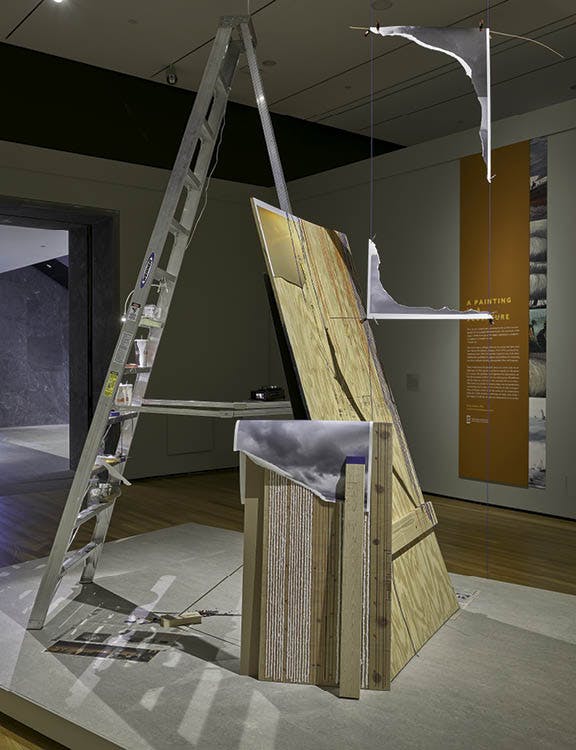
Installing a Unique Sculpture
- Magazine Article
- Collection
The installation of Sarah Sza's Plywood Sunset Leaning as seen in Stores from Storage followed a 101-page manual

Plywood Sunset Leaning (Fragment Series) 2015. Sarah Sze (American, b. 1969). Acrylic paint, wood, archival prints, ladder, mirror, paper cups, stone, lamp, tools, pen, tape, paint brush, newspaper; overall: 350.5 x 292.1 x 190.5 cm. Gift of Agnes Gund, 2015.145.
© Sarah Sze
Of all the artworks we prepared for display in Stories from Storage, Sarah Sze’s Plywood Sunset Leaning loomed largest in my mind. I had heard about it from colleagues and seen parts of it arranged and carefully labeled in our storage area, but this was the first time it would be installed at the museum. The work consists of a 12-foot ladder, with a large mirror and sections of plywood leaning against it, and many small pieces of dried acrylic paint, wood, archival prints, used Coke cups, empty water bottles, pieces of stone, tools, a pen, a knife, balls of tape, a paintbrush, sheets of newspaper, and a working lamp, all of which are arranged on or around the ladder.
To prepare, I read an interview between Sze and CMA conservators recorded when the work was first acquired. She spoke about the idea of leaning, saying that the work should appear to rely on gravity, holding itself up. She also noted that the Coke cups and water bottles, as evidence of human presence, gave a sense of the process of the piece being made. She wanted this feeling to stay with the work, as though it had just been created right before the visitor walked in. These two ideas resonated with me as I worked on the installation with art handlers Arthur Beukemann and Andrew Robison, and we began to fully understand all the labor that goes into achieving the effortless, “woke up like this” appearance of this artwork.
Sze’s studio had prepared a 101-page illustrated manual, to ensure that every element was placed properly. Each of the small items on the steps—a ball of tape, a dried strip of paint, a torn scrap of paper—has an ID number corresponding to a location tag on the ladder. As I placed each one, I secured it to the ladder with small dots of adhesive or wax. The large plywood sheets and the mirror, while they may look like they’re just leaning, are secured with hidden brackets. Wherever possible, Arthur and Andrew took additional safety precautions, like bolting the ladder to the floor and adding wedges and other invisible supports. The hanging element with the torn pieces of paper floats gracefully, but it took Arthur a few hours to assemble, measure, level, and suspend it from the ceiling at the exact specified angle and height.
I know it might seem strange—as it did to me at first—to think of sheets of newspaper, scraps of paint, and tape as artwork. These are not permanent or archival materials, and, in fact, we usually avoid them in museum storage areas, because we know they don’t last. The newspaper will become yellow, the cups will deteriorate, and the paint strips may become brittle and cracked. In the interview, the artist was asked about this; she does want items replaced as they start to look damaged, even if Coke changes its logo or the shape of the new water bottle is different. Having the artist’s input in this case is invaluable, as it helps us and future conservators make decisions that will best preserve the artist’s intention and ideas for generations to come.

Cleveland Art, Spring 2021